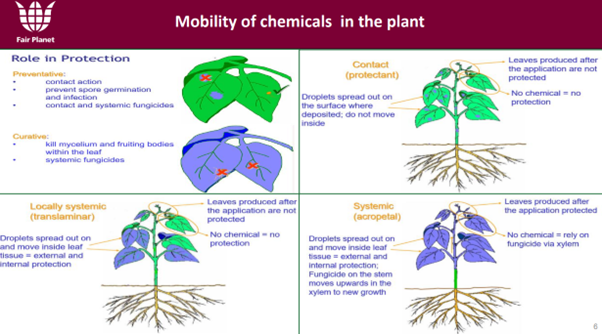Guidelines for safe and effective use of chemicals in agriculture for crop protection

This post is also available in:
This post is also available in:
![]() हिन्दी (Hindi)
हिन्दी (Hindi) ![]() Português (Portuguese (Brazil))
Português (Portuguese (Brazil))
Guidelines for safe and effective use of chemicals in agriculture for crop protection

With the wisdom of Fair Planet – The guidelines presented below are shared by the Fair Planet team with the farmers
How to use agrochemicals safely for you and the environment
Crop protection is still highly dependent on the application of agrochemicals like pesticides, either as a unique pest control measure or as part of an integrated management program. Pesticides are agrochemicals used for controlling unwanted crop pests and diseases.
Based on data published by FAO, the total pesticide use in agriculture was around 4.2 million tonnes (Mt) of active ingredients (in 2019), with an average pesticide application of 2.7 kg per hectare of cultivated land. The map below shows the pesticide use per cropland area.
The extensive use of such products, in combination with their (relevant) toxicity, can put the users, the crop itself, and the environment at risk. As a result, it is vital to follow some safety tips while handling pesticides.
Basic Principles for Effective Chemical Applications
- Mode of Action (MoA):
Each chemical has a different MoA that attacks different processes of the pest/disease. See the link with info on the MoA of various active ingredients: https://irac-online.org/mode-of-action.
Consult with an expert to identify the most effective MoA for a specific pest.
- Rotation between Chemicals:
It is very important to rotate between various chemicals with different MoA. When using chemicals with the same MoA for treating the same pest, there is a high risk of pest resistance development. Doing it will make it harder or even impossible to control the pest in the future.
Keep in mind that there are usually numerous commercial products with the same MoA or the same active ingredient. Therefore, make sure to rotate with products (e.g., pesticides) with different MoA. Always check the label or ask your local agronomist or extension expert.
- Know the way your product works:
Chemicals used in plant protection (pesticides, fungicides, herbicides, etc.) may have a contact action or systemic action. To control the crop “enemy,” it is important to know if the product you are using has a systemic action or not and how long it remains active.
- Use only locally registered products suitable for the crop of interest:
It is essential to purchase only locally registered pesticides and fungicides from licensed pesticide dealers. Make sure that the specific product is suitable to be used for the pest and the crop of interest. Always check the expiration day of the product. It is preferred not to store large quantities of agrochemicals.
- How to spray the plant:
Make sure that all parts of the plant are covered with the spray, including the lower parts and the top of the plant.
- Repeated use Per Season/Crop:
Always read the “chemical’s Label” and avoid using a specific chemical more times than the maximum indicated in it (usually no more than 3-4 times). Over-use of the same active ingredient or same MoA might cause the pest/disease to develop resistance to the chemical.
Precaution measures and Safety tips for agrochemicals
Except for the effectiveness in protecting the crop, a farmer should take all necessary measures to protect himself/herself, the community and the environment when handling agrochemicals like pesticides, fungicides and herbicides.
All necessary precautions must be observed according to the label of the chemical and the following instructions:
Check the toxicity level of the product mentioned on the product label. There are 4 levels of toxicity, indicated with 4 warning statements:
- Dangerous Poison – (Extremely) High Toxicity (Red label)
- Poison – Highly toxic (Yellow label)
- Danger – Moderate toxicity (Blue Label)
- Caution – Low toxicity (Green label)
The level of toxicity defines the level of protective measures that need to be taken. In any case, we suggest that all farmers should follow the safety measure presented below:
- The person applying the chemicals (the operator) must wear a mask, long-sleeved clothes, and solid shoes when spraying. Avoid putting your trousers inside your high boots because this can create a flow of the chemical to your feet and the chemical may accumulate inside the boots.
- Read the first-aid instructions and always handle the chemical cautiously in a well-ventilated or open space.
- When mixing liquids, eye and hand protection are also required. A dust mask is required when mixing powder formulations. Wash gloves before removal to avoid potential contamination.
- Wash your hands after every contact with chemicals.
- Avoid touching the eyes. In case anything gets into the eye, rinse well for 5 minutes with running water and then get medical help. If you feel sick after applying or handling agrochemicals, contact your doctor immediately.
- Do not eat or smoke when handling chemicals.
- Do not mix chemicals before consulting the label and the chemical’s database instructions.
- Use the suggested dose and avoid unnecessary use. Excessive use or high amounts can lead, among others, to phytotoxicities and damage to the plants. Protect the natural enemies of the crop pests and other fauna.
When to apply the pesticides
- Spraying should be done in the early morning or in the (late) afternoon.
- Do not spray in strong sunlight hours as the spraying may scorch the plants (especially oil-based materials).
- Do not spray when rain is expected or soon after the rain, as the moisture on the plants may wash off the chemicals.
- Avoid spraying in days with strong winds and always spray in the wind direction (never against it).
- Prefer pesticides that are bee-friendly. In any case, it is best to spray when the bees are not active (late in the afternoon), if possible not during flowering, and always after informing neighbour beekeepers.
- Always respect the minimum days from the chemical application until the harvest of the product. Read the product label.
Storing – Disposal of pesticides and other agrochemicals
- Cleaning and maintenance: the spraying equipment is expensive and delicate and has to be handled properly: after every use, all parts must be rinsed thoroughly with clean water (to avoid a mixture of chemicals between different sprayings).
- If you use the same sprayer for herbicides, it is of utmost importance to clean it in a thorough manner before using it for pest control. Residues of herbicides in the sprayer can severely damage your crop.
- Store the agrochemicals in well-closed packages in cold/moderate temperatures in protected areas, away from kids and animals and away from sun or rain. Avoid transferring chemicals from their original packaging to another package, and always take care to keep the product label.
- Do not use equipment intended for applying chemicals or their packages for any other purpose (such as storage or packaging).
- Do not dispose of excess agrochemicals left over in the sprayer, in the environment, and/or in water sources. Contact your local state’s environmental agency or household hazardous waste, if any, to learn where you can dispose of your unwanted pesticides or leftovers. The same is true for the empty containers of chemicals.
To find more detailed information, you can contact the author and Fair Planet.
About Fair Planet
Fair Planet is a non-profit development organization that works with smallholder farmers in Africa to free them from the cycle of extreme poverty and food insecurity. Aligned with the UN’s 2030 Sustainable Development Goals, our innovative, proven operational model has been designed to scale outreach and maximize impact, leading to sustainable economic growth, climate-change resilience, and greater regional food independence. Our vision is a world where all farmers have equal opportunities to achieve sustainable economic growth and prosperous lives for their families. Our mission is to improve the capacity of smallholder farmers in developing countries to transform subsistence agriculture into a profitable source of income through access to high-quality seeds and technological solutions supported by agricultural knowledge and skills.








































































